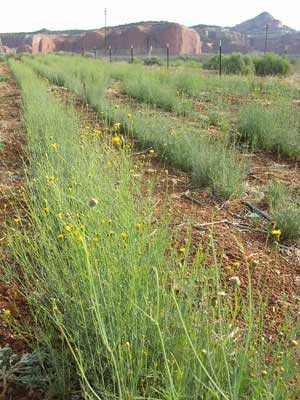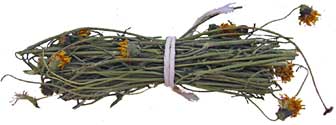Return to ITM Online
GREENTHREAD: NAVAJO-HOPI TEA
A Relative of the Herb Bidens, Used as a Health Tea
by Subhuti Dharmananda, Ph.D., Director, Institute for Traditional Medicine, Portland, Oregon
BACKGROUND
Greenthread (Thelesperma spp.) is an herb used to make a beverage tea-sometimes used medicinally-by several Native American tribes, particularly those in the southwest. The tea has been called Navajo Tea, Hopi Tea, or Indian tea, to reflect its use by these populations. The designation greenthread is most appropriate, as the herb has thin leaves that are thread-like. The herb grows over much of the plains and mountain states, reaching up to Wyoming, Montana, Nebraska, and South Dakota. Still, its main use is in the Southwest, and the plant grows abundantly on the Navajo, Hopi, and Pueblo lands, as well as throughout much of New Mexico, Arizona, and Colorado. The extended range of habitat is made possible by the fact that several species exist (see table), some only at high altitude, others growing in the plains, and virtually all of them can be used to make greenthread tea. The herb known as Navajo tea is derived mainly from T. megapotamicum, T. simplicifolium, T. filifolium, and T. subnudum. The genus Thelesperma is distinctive to North America.
| 
|
The traditional method of preparing the herb is to harvest the plant just as the flower buds open, cutting it about 2-3 inches above the soil (which allows re-growth of the plant next season), and then washing the plants. The dried plant is folded into somewhat uniform lengths, about 4 inches, and bundled with string into units of about 6 grams each for storage and use.

Thelesperma lowers before opening.
| 
Thin stalks and leaves.
| 
Bundles of leaves, stems, and flowers.
|
The tea is made by boiling a bundle of the herb in about 6 cups of water (some consumers use considerably more water) for about 5 minutes. Sugar or honey can be added to sweeten, though the taste, something like that of standard green tea, with a very slight aromatic taste, is enjoyed without any sweetener. Teabags of the herb are also available.

Cultivation plot at "high desert farmers" near Gallup..
| 
Outline of Colorado Plateau, showing Gallup in New Mexico.
|
The herb (T. megapotamicum) is now cultivated in New Mexico, on the Colorado Plateau, at an altitude of about 6,500 feet; these are ideal growing conditions for it. Production is currently limited, but plans for expansion are underway in order to yield sufficient quantities of organically grown tea to supply a growing interest in healthful beverages.
| Products of High Desert Farmers
|

Bundle of greenthread.
| 
Box of greenthread tea in teabags.
|
CONSTITUENTS AND ACTIVITY
In addition to the use of the herb as a beverage, greenthread is reputed to be beneficial for the kidneys (mildly diuretic), to alleviate digestive problems (especially stomach cramps), and to purify the blood. Little study has been undertaken to determine the active constituents of greenthread. Flavonoids have been found, and these include luteolin, which is likely the main yellow color of the flowers (used as a dye; see sample use next page); the plant also contains chalcone glycosides, notably marein. Greenthread is closely related to another herb, bidens, in the same plant family: T. megapotamicum is also known as Bidens megapotamicum because of the similarity of the genera, particularly for this species. Bidens plants contain both luteolin and chalcone glycosides.
Bidens is widely used in Chinese medicine; the most commonly used species there is Bidens pilosa. Several of the flavonoids found in Bidens pilosa have anti-inflammatory activity as revealed in laboratory animal studies. The flavonoids from another species of Bidens, B. aurea, were found to inhibit stomach irritation induced by stress or by elevated levels of acid in the stomach in laboratory animal studies. Several species of Bidens in Africa were screened for ability to treat headache and inflammatory diseases, with the finding that the flavonoids inhibited cyclooxygenase (COX); COX inhibitors are a major area for research today in anti-inflammatory drug development. Mixtures of Bidens species have been used in treating cardiovascular disease in Taiwan, and it was found that these herbs lowered blood lipids in laboratory animal studies; they could also improve blood flow, reduce platelet sticking, and lower high blood pressure.
Bidens is also used as an herbal tea, such as the Kookoolau tea from Hawaii. It is likely that greenthread has actions similar to the better-studied bidens, though this will only be assured with further investigation. Fortunately, the good taste of greenthread is adequate reason to consume it.

| 
| 
|
| Bidens ferulifolia; found in New Mexico, Arizona, and northern Mexico; it has similar thin leaves and yellow flowers as seen in Thelesperma.
| Navajo artist Kady Sun frequently uses a yellow dye from the greenthread plant. The dye is made from the flowers and twigs of the plant, boiled for several hours; the leaves produce a rust-colored dye.
| Kookoolau, the Hawaiian bidens, is used to make a beverage tea, and is considered a medicinal herb; its claimed properties are similar to those mentioned for greenthread.
|
MEMBERS OF THE GENUS THELESPERMA
Over several decades of botanical research, a number of species and varieties of Thelesperma have been identified. Continuing botanical work has suggested that some of the identifications overlap, and the plants should be considered of the same species. In the following table, the left hand column presents species and varieties (var.), where an equal sign (=) means that the terms are currently considered synonymous (or, in two cases, that they "may be" synonymous). Several of the common names given to these species are provided in the second column, along with information about geographical distribution of the plant.
| Botanical Nomenclature
| Common Names, Notes on Distribution
|
T. megapotamicum
= T. gracile
= T. ambiguum
= T. fraternum
= T. megapotamicum var. ambiguum
= Bidens megapotamicum
| Colorado greenthread, slender greenthread, rayless greenthread, Navajo tea, Hopi tea, cota [Spanish term].
Distribution includes: high elevation (4,000-7,500 ft) sites in New Mexico, Arizona, Colorado, Texas, Oklahoma, Wyoming, Nebraska.
|
| T. simplicifolium
| Slender greenthread, Navajo tea; found in dry calciferous soils in Arizona, New Mexico, and Texas.
|
T. filifolium
T. filifolium var. filifolium
= T. trifidum
T. filifolium var. intermedium
= T. intermedium
| Stiff greenthread, Navajo tea, showy Navajo tea, Plains Navajo tea.
Widespread distribution in the Great Plains region, and also further to the southeast, into Louisiana, Mississippi, and Arkansas.
|
T. subnudum
T. subnudum var. alpinum
may be = T. pubescens [see below]
T. subnudum var. caespitosum
may be = T. caespitosum [see below]
T. subnudum var. marginatum
= T. marginatum Rydb.
T. subnudum var. subnudum
| Navajo tea, border greenthread, northern greenthread.
Distributed in western mountain states, Arizona, New Mexico, Colorado, Nevada, Utah, Wyoming, Montana, into Alberta, Canada.
|
| T. burridgeanum
| Burridge's greenthread; found only in Texas.
|
| T. caespitosum
| Low greenthread, Green river greenthread (rare species, possibly endangered; found only in Utah and Wyoming).
|
| T. curvicarpum
| Edwards Plateau greenthread; found only in Texas.
|
| T. flavodiscum
| East Texas greenthread; found only in Texas.
|
| T. longipes
| Longstalk greenthread; limited distribution in Arizona, New Mexico, and Texas.
|
| T. nuecense
| Rio Grande greenthread; found only in Texas.
|
| T. pubescens
| Hairy greenthread, Uinta greenthread, Bicknell thelesperma (rare species, possibly endangered; limited distribution in high mountain areas of Utah and Wyoming). |
January 2004










